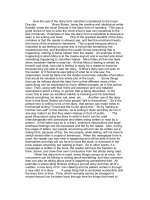How make use of PHP building
Bạn đang xem bản rút gọn của tài liệu. Xem và tải ngay bản đầy đủ của tài liệu tại đây (3.93 MB, 40 trang )
Learn To Build With PHP: A Crash Course
By Matthew Hughes, />Edited by Justin Pot.
This manual is the intellectual property of MakeUseOf. It must only be published in its
original form. Using parts or republishing altered parts of this guide is prohibited without
permission from MakeUseOf.com.
Think you’ve got what it takes to write a manual for MakeUseOf.com? We’re always willing
to hear a pitch! Send your ideas to ; you might earn up to $400.
Table Of Contents
1. Introduction
2. Hello World!
3. Forms
4. Databases
5. Getting Content From The Database
6. Logins And Authentication
7. Conclusion And Further Reading
MakeUseOf
1. Introduction
What was your favorite subject at school?
If you’re anything like me, I bet you loved the arts. The humanities. You know, the subjects
derided by some as being vacuous and nebulous in nature, but regardless you loved
studying them because you loved being creative.
I bet you never thought of your IT classes in the same way you thought of English Language
or art; as a purely creative endeavor.
That’s a pity. Learning to program is a bit like doing a creative language class. You have an
idea, and you can execute that however you like. It’s pure creativity, but instead of baring
your soul on paper, you are commanding a computer to do your bidding. If you can dream
it, and if you can describe it in a way your computer understands, then you can make it.
The way we talk to computers is through abstractions called programming languages.
There are a whole bunch of these out there, each with their own advantages,
disadvantages and truly bizarre idiosyncrasies. They’re imperfect by nature, but people use
them to create incredible and wonderful things.
One of these languages is called PHP.
You may have heard of it before. This is the language that Facebook, WordPress and
Wikipedia use to serve billions of requests, daily. It is the de-facto language used for
teaching people to program for the web. It’s beautifully simple, but brilliantly powerful.
And in this guide, I’m going to teach you how you can use it to build your own websites.
Do you have a killer startup idea you don’t quite know how to execute? Do you want to
learn the language used to extend WordPress? Are you just curious about web
programming? Do you just want to learn the skills needed to stay relevant in the modern,
tech-oriented knowledge economy?
Whatever your motivation, this book aims to teach you the basics of the PHP programming
language. But first, let’s have a bit of a history lesson.
1.1 The History Of PHP
In the infancy of the Internet, things were a bit… Well? Flat.
Sites weren’t particularly interactive, and those who visited these sites were faced with a
relatively one-directional experience. Adding even the simplest aspects of user engagement
was incredibly difficult, left in the domain of the computer scientists and the expert
programmers.
And then Rasmus Lerdorf came around. This Canadian-Greenlandic coder created the PHP
programming language, which allowed people to easily add the simplest facets of
interaction to their web pages. It was new, it was brave, and it took off almost immediately.
Rasmus Lerdorf couldn’t have predicted the impact his idea would have upon the world.
A community began to form, with programmers and companies willingly providing time and
money to fuel the development of the language. Slowly but surely, PHP began posing a
serious challenge to Sun (now Oracle) and Microsoft, who were hoping to gain traction in
the web-development market with their Java and ASP platforms. The rise of the PHP
programming language could only be described as startlingly rapid.
That was 20 years ago. An age, in the computer world. Since then, the PHP programming
language has become the preferred way for millions of programmers, who use PHP in their
jobs, to get involved in open source and to bring their ideas to life. It’s a staple of the digital
world.
You can become one of those millions. This book will show you how.
1.2 What Are We Going To Cover?
This is a pretty short book, but we’re going to cover a lot. In just a few pages, we’re going
to create a simple clone of Twitter.
Whilst it’s not going to have the same feature-set and polish of the popular micro-blogging
site, but we will be able to post 140 character messages with an account we will log into.
1.3 All About LAMP
By now, we should know that PHP is an incredible language for creating interactive web
pages. But we haven’t talked about how we turn that code into a real-life product. So, let’s
do that.
For the most part, PHP code runs within a web server. A web server is responsible for
sending web pages to anyone who navigates to a specific domain name or IP address.
The most common choice of web server is the ludicrously popular Apache web server. This
open source, cross-platform software project powers the majority of the Internet, with 45%
of all websites serving pages from the Apache web server. However, it’s helpful to note that
there are other web servers available, including LightTTPD and Microsoft’s IIS.
This forms the second letter in the LAMP acronym, which stands for Linux, Apache, Mysql
and PHP. We know what PHP is. I just explained to you what Apache is. You might have
heard of Linux at some point. But what is the ‘M’ in Lamp? MySQL.
Let’s talk about MySQL. I’d put money on your website having to store information that your
web application has gathered. What’s more, I bet you’d want to store that information
somewhere that is structured, safe and organized. Yep, you’re going to have to use a
database, and for most purposes MySQL is a pretty solid choice. We’re going to talk about
this later on.
Finally, let’s briefly touch on Linux. Most PHP websites are served from systems running the
popular, open-source Linux operating system. However, you don’t have to use Linux as your
development environment if you don’t want to. Everything in this book can be used on OS X,
Windows and Android
An operating system, Apache, MySQL and an installation of the PHP programming
language are the four constituent parts of the most common PHP configurations. But how
do we get our hands on them?
1.4 Setting Up Your Development Environment
Unlike some programming languages, setting up a PHP development environment is easy.
Indeed, there are a number of packages which do all the hard-work for you, and save you
the hassle of installing each component (PHP, MySQL and Apache) individually.
Windows
The easiest way to set up a PHP development environment in Windows is with XAMPP by
Apache Friends. This package includes MySQL, a copy of the PHP programming language
and the Apache web server, as well as an administrative control panel, and plugins for SSL
(the protocol used to encrypt traffic on a network) as well as sending Email.
XAMPP is free, and can be found on the Apache friends site. It’s important to stress that
there are two versions of XAMPP available. One has a version number of 1.8.2 and runs a
slightly older version of the PHP programming language, and the other has a version
number of 1.8.3 and runs a current version of PHP. Whilst I would strongly recommend that
you download the latest version, the contents of this guidebook should work with both.
Linux
Linux is a bit tricky. There are a number of operating systems that exist under the ‘Linux’
umbrella, although they each handle the installation of software packages in different ways.
If you’re using Ubuntu and any distribution which uses the Ubuntu repositories, you can run:
sudo apt-get install lamp-server^
This will install a LAMP server, with all the components required for following this article.
This process is explained in greater depth in this article, where I show you how to install a
LAMP server as part of installing the WordPress blogging platform.
These instructions will not work on distributions that use YUM or RPM for their package
management, with the instructions for setting up a LAMP server differing significantly. I
would recommend you to have a look at the documentation that came with your operating
system.
However, there is another option. Remember XAMPP? Well, it just so happens that it
comes with support for Linux, and can be downloaded here. However, where possible, I
would strongly recommend that you install your LAMP server through your package
manager.
There are a few reasons for this. Firstly, it would be slightly better integrated with your
operating system and can be easily updated. Furthermore, installing PHP via the command
line is good practice should you ever deploy your application to a VPS server.
OS X
I use OS X as my main development platform. I like the flexibility it provides me, and setting
up a PHP development environment in OS X is insanely easy.
I’m quite partial to MAMP. This comes in two products, with one being free and the other
costing $59 USD (or €39). However, the free version is more than adequate for the
purposes of this guide book.
Getting MAMP is a matter of grabbing a ZIP file from the website, double-clicking a pkg file
and pressing ‘continue’ as often as necessary.
As before, it’s entirely possible for you to create a PHP development environment using
XAMPP, which is also ported to OS X. It’s entirely up to you.
Android
Android? I mean, Android is great for sending tweets and killing time on Angry Birds. But
software development? Nah. right?
Wrong. If you’ve bought an Android cell phone in the past year or so, odds are quite good
that it’s running a CPU that’s just as powerful as any VPS you’ll get for under $10. And that
means that it’s good enough to run PHP, Apache and MySQL.
There are a lot of Android LAMP servers on the market, but I really like Palapa Server. It
runs nicely on an aging Nexus 7 tablet, and I’ve even managed to shoehorn Android onto it
without any real difficulties. It’s not the ideal development environment, but it’s possible.
1.5 Choosing The Right Text Editor
You’re probably familiar with what word processors are. Odds are good that you’ve used
Microsoft Word, Open Office or Google Docs to write letters, school assignments or
business documents.
But you might not know that it’s not possible to use a regular word processor to develop
software and websites. Why is that? Mainly because when you write a document, you leave
all sorts of extraneous markup and formatting in the file. The end product isn’t just the
words you write, but also the alignment of each word and its styling.
As a result, when writing code, we use text editors. What are they? Simply put, these allow
you to write files which are saved in purest plaintext. No formatting. Just characters.
When writing code, I tend to use Sublime Text 2. It comes with an indefinite free trial
(although, it does occasionally nag you to upgrade), and heaps of features, which makes
writing software with it a joy.
In particular, it comes built in with syntax highlighting for PHP, Javascript and HTML, which
makes it really easy to read the code you produce. You can download Sublime Text 2 here,
and it is available for Linux, Windows and OS X. If you’re not convinced, you can read more
about Sublime Text 2.
If you’re on Android, you’ll find that your choices are quite limited. I’m fond on VimTouch,
which is available for free on the Google Play store. Vim has a pretty steep learning curve,
but it’s well worth a try. Read more about why it's worth giving Vim text editor a chance.
1.6 Prerequisites
We’re going to jump straight in to learning PHP. Whilst I plan to gently introduce you to this
amazing programming language, there are some things I’m expecting you to understand
beforehand.
Specifically, I’m going to expect that you understand how a website is structured with
HTML. If you don’t know your <p> tags from your <span> tags, that’s not a problem.
MakeUseOf has a XHTML book which will bring you up to speed. Read through that and
once you’re feeling confident, read on.
Feeling adventurous? Why not learn about the latest version of HTML with our HTML5 e-
book? Whilst it’s not essential, it might help you later on.
2. Hello World!
Time for a whistle-stop tour of PHP. And where better to start than the traditional ‘Hello
World!’ program.
But first, we’re going to need to know where to store our PHP files. We store them in a
place called the ‘Document Root’, which sounds complicated, but it really isn’t. All that
means is whatever is stored in this folder will be available to anyone who visits the
computer’s IP address with their web browser.
The location of your document root varies on how your PHP environment is set up. If you
are using MAMP on OS X, you can find it in /Applications/MAMP/htdocs. If you’ve installed
your LAMP server on Linux using your distribution’s package manager, your Document Root
directory will most likely be /var/www. On XAMPP, your root directory is located in
C:/xampp/htdocs/.
Once you’ve navigated to the Document Root folder, create a file called ‘index.php’ and add
the following lines.
<!doctype html>
<html lang="en">
<head>
<meta charset="UTF-8">
<title>Microblogging Site</title>
</head>
<body>
</body>
</html>
Nothing’s going on here, but we do have the skeleton of a web page. This homepage will be
found at ‘localhost’. Sometimes it’s followed with a port number, which usually is ’80’, ‘8888’
or ‘8080’. Although, depending on the PHP development package you use, can vary. If
you’re unsure, refer to the documentation.
Now, let’s write our first lines of PHP! In between <body> and </body>, write
<?php echo(“Hello World!”); ?>
So, let’s break this down.
All PHP code has to be between a ‘<?php’ and ‘?>’. If it isn’t then the web server will not
execute it. Then, we have ‘echo’. As I’m sure you’ve guessed, this function prints content to
the browser. Finally, we have the content we want to print out. This is surrounded in
parentheses and speech marks. It’s worth noting that parentheses are (for the most part)
optional, when it comes to calling a function.
As we have finished the ‘echo’ statement, we finish it with a semicolon. If this is missing,
your code will not work.
If it works, you should see ‘Hello World’ in your browser.
2.1 Does PHP Have To Be Surrounded By HTML?
No.
If we’re performing an action that should be displayed immediately within the web browser,
we can have it nested within the HTML document. This is called inline PHP, and that’s what
we used to print ‘Hello World’ to the screen.
However, for anything more complex, we should always aim to put it in its own PHP
document. As with the previous example, the file should end with a ‘.php’ extension and all
code should start and end with ‘<?php’ and ‘?>’.
2.3 Basic Language Concepts
Before we go on, let’s look at some language concepts in PHP. Whilst this isn’t an
exhaustive list, it does include the essentials required to be productive as a PHP
programmer. Once we’ve gone through these, we’re going to look at using some of these
concepts within the context of forms.
Variables
Variables are a concept found in virtually all programming languages. They are used to
store a value, which can be retrieved, used and changed later on.
You might be familiar with a language that requires you to specify the value of a variable.
These include C#, C, C++ and Java, and usually look a bit like this.
int x = 10;
You also might be familiar with Javascript, where variables are declared with the ‘var’
keyword.
var x = 10;
In PHP, however, variables are declared with a dollar symbol.
$x = 10;
PHP variables cannot start with a number or a special character other than an underscore.
Furthermore, they cannot be called ‘this’, as this is a reserved keyword.
If Statements
If statements are useful. They allow you to execute code contingent upon a specific
condition being met. Consider the following code.
$x = 5;
if ($x == 4) {
echo(“Hello World”);
} elseif ($x == 3) {
echo(“Hello Dave”);
} else {
echo(“Hello Brian”);
}
So, the first condition being examined is if $x equals four (note the double equals symbols).
Since it isn’t, the PHP interpreter will look at the next conditional statement, which is if $x
equals 3. If it doesn’t, it will move on to the final statement, which will echo out ‘Hello Brian’
if none of the conditions have been met.
You can check if a variable is empty (also known as ‘null’, or a ‘null value’) by preceding it
with a ! in the ‘if’ statement. For example:
if (!$x){
echo(“x is empty”);
}
While Statements
While statements execute code repeatedly whilst a condition is being met. Consider the
following code.
$x = 10;
while ($x > 1) {
echo($x);
$x = $x - 1;
}
This code looks at the value of $x, and if it is greater than one, it will echo the value of $x
and then remove one from it. It will do this, until the condition of ‘$x > 1’ is no longer met.
That is to say, that it equals 1 or less.
For Loops
For loops are, as a concept in programming, often quite intimidating to beginners. They
shouldn’t be, though. Whilst they’re ostensibly quite complex, they’re really easy to
understand when broken down. Let’s write a simple for loop that counts from one to ten.
for($i = 0; $i < 10; $i++){
echo($i);
}
What’s happening here? Well, first we create a variable with a value of 0 ($i = 0;). We then
set the condition of ‘if $i is less than 10, carry on’ ($i < 10). We then add one to I ($i++) and
execute the contents of the curly braces, looping back on the original code.
Functions
Functions are a useful tool when it comes to programming. They allow you to write code
that is more consistent, and spend less time writing the same things over and over again by
compartmentalizing code into a single snippet that can be called when required.
They’re also really simple to create. This is how we make a function that echoes out ‘Hello
World’ when called. This function will be called ‘sayHello()’.
function sayHello(){
echo(“Hello World”);
}
You can also pass functions values. These are known as parameters, and are put within the
two parentheses in the first line of the declaration. For example:
function sayHello($hello){
echo($hello);
}
And can be called as follows:
sayHello(“Hello World”);
Finally, we can get functions to return values.
function returnHello(){
return “Hello World”;
}
And can be used as follows.
x = returnHello();
echo(returnHello());
2.4 Moving On
We’ve learned the basics of flow control in the PHP language, as well as how we can use
variables and functions to store values and snippets of code for future use. In the next
chapter, we will expand upon our understanding of the PHP programming language by
looking at how we can capture data with forms, thus forming the first piece of our Twitter
clone.
3. Forms
3.1 How Forms Work In HTML
Forms are everywhere.
No, seriously. They are. When you leave a comment on MakeUseOf; when you buy
something off Amazon and have to write down your address and credit card numbers; when
you compose and submit a Tweet, you are filling out a form.
I know I sound like a broken record, but if you haven’t read the MakeUseOf HTML5 guide,
you should. You don’t need it for this chapter, but it’ll show you some cool tricks you can do
with forms in the latest version of the HTML markup language.
3.2 Creating Our First Form
You’ve probably seen Twitter before.
The core of a Tweet is a multi-line text box, and a button that submits it to Twitter’s servers.
So, how do we create a rudimentary version of that in HTML? Well, it looks something like
this:
<body>
<form action="postForm.php" method="post">
<TextArea name="microBlog" id="microBlog" cols="30" rows=“10">
</br>
</TextArea>
<input type="submit">
</form>
</body>
So, let’s break this down.
A form is enclosed within form tags. Form takes two arguments, with the first being a link to
a PHP file which contains the code that handles our form. The second is a method, and this
refers to how you send data to the web server. These can either be ‘post’ or ‘get’.
Inside, we’ve got a TextArea element. Do you know what the difference between a
TextArea and input element is?
It’s a really subtle difference. They do pretty much the same thing, although a TextArea
element allows you to input multiple lines of content, whereas an Input (when not used to
submit a form) can only accept one line of content.
Since we’re creating a clone of Twitter, we’re going to use a TextArea element to capture
the post. This element takes a few arguments. The first two are ‘name’ and ‘id’, which
we’ve given the value of ‘microBlog’. The second two are ‘cols’ and ‘rows’, which we have
given the values of ’30’ and ’10’ respectively. These can be adjusted, as you see fit.
Finally, we have an input element. This has a type of ‘submit’, and is rendered in the
browser as a button. Once pressed, it will pass the contents to ‘postForm.php’.
We should have something which looks like this. Not the most pleasant thing in the world,
but we’ll worry about that later.
3.3 Handling This Input With PHP
In keeping with the gentle pace of this book, we’re going to just look at how we can capture
the input, and then print it to the screen. We’ll look at persistence and storing it in the
database later on.
So, remember that postForm.php file we mentioned earlier? Create that in the document
root.
Now, add the following lines.
<?php
$microBlog = $_POST['microBlog'];
echo $microBlog;
?>
So, what’s that $_POST thing then?
Well, that’s what we call a super-global variable. That sounds complicated, but it isn’t. In its
simplest form, it means that whenever we need to reference a form input, we have to use
that. At the end of $_POST, we write the ID of the form input we’re referencing. This has to
be sandwiched between square braces and quote marks.
We assign the contents of the ‘microBlog’ to a variable, and then echo it to the screen.
Simple, really.
But does it work? Let’s give it a try.
We navigate to our homepage and write something into the form. Then, we press ‘submit’.
As you can see, our input is returned back to us. Here’s a question though. What happens if
we close our browser tab and reopen localhost/postForm.php?
There’s nothing there. Niet. Nada.
That’s because it’s not stored anywhere, except in the short-term memory of our web
browser. Once it’s gone, it’s gone.
However, there’s an easy way to ensure that our data is retained forever. We have to put it
into a database. Whilst at first they’re not the most exciting subject ever, they’re pretty easy
to get the hang of.
And in the next chapter, I’m going to show you how you can store your tweets in a
database.
4. Databases
I have a confession to make. I really like databases.
Ever since computers were invented, we’ve needed to store content. Everything from the
password you use to log into Facebook, to the configuration of your computer, to your bank
account, is stored in a database. Earlier versions of databases were fundamentally primitive
and limited. Since then, they have evolved and advanced, improving the speed and reliability
of their functioning. This is largely a result of 50 or so years of development.
One way of storing data is with a relational database. This paradigm of storing data was
introduced in the 80s and relies upon a mesh of interconnected tables, with data organized
in rows and columns.
There are a huge number of database management systems that use this paradigm (known
as RDBMS’), including Oracle, MsSQL and MariaDB. But we’re only going to look at one.
MySQL.
MySQL is a modern database management system. The number of websites which depend
on it is dizzyingly large. It is the database behind WordPress and Facebook, and is based
upon the reliable relational database paradigm.
Advantages of the MySQL database are too numerous to mention.
Firstly, it’s free; both in cost and in terms of licensing. It can be found running on every
platform, having been ported to some of the most obscure operating systems in the world.
Moreover, it’s a reasonably lightweight software package, and can run quite comfortably on
most low-powered VPS systems.
It’s also remarkably easy to get started with MySQL, and there is a huge wealth of
information out there for people who would like to get their feet wet with it, including some
incredibly detailed and accurate user generated documentation.
In order to interact with MySQL, we need to use the SQL (Structured Query Language)
programming language. This allows us to perform complex queries against a database,
whilst strongly resembling written English. As a result, it is really easy for beginners to get
started with.
But before we get to that, let’s talk about MySQL datatypes.
4.1 MySQL Datatypes
MySQL requires that each column in a table be categorized with a specific datatype. For
example, someone’s age would be categorized as a number, whilst someone’s name would
consist of a variable number of alphabetic characters.
We specify datatypes to ensure the consistency of the data stored in the table.
Whilst this sounds complicated, I assure you it isn’t. What we’re talking about is knowing the
data that we’re planning to retain, and knowing how to classify it.
There are a huge number of datatypes in MySQL. We’re only going to talk about two, which
are more than adequate for the purposes of this book.
Varchar(x)
When you’re inputting content that can contain a variance of numbers, special characters
and letters, you’re recommended to use a varchar field. These can be of varying length. A
field size with a maximum length of thirty characters can be represented with varchar(30).
Integer
When storing numbers, we use an integer value. These can range from -2147483648 to
2147483647, although there are more datatypes available if you need to represent larger
numbers. In that case, refer to the MySQL manual.
Other MySQL Datatypes
There are a huge number of datatypes available, which can be used to represent and retain
all sorts of data. These include large pieces of text, true or false values and binary files. If
you’re curious to learn more, have a look at the MySQL documentation.
4.2 Creating Our Database
Okay, now it’s time to start working on a database for our Twitter clone.
Firstly, we need to connect to MySQL. If you’re using Linux and you’ve installed MySQL
through your package manager, you can connect through the terminal with the following
command.
mysql -u root -p
Upon which, you will be prompted for your password.
Users of XAMPP and MAMP can use PHPMyAdmin, which comes bundled in and allows
you to edit your database with a nice web interface.
So, first we need to create the database for our website and create a table to hold our
microblog posts.
Either through PHPMyAdmin or through the MySQL console, run the following lines.
CREATE DATABASE MicroBlog;
USE MicroBlog;
CREATE TABLE MicroBlog (
id integer auto_increment,
post varchar(255),
primary key (id)
);
Unless you see an error message, your table has been created without a hitch.
So, a few things you might have noticed there. Firstly, we’re ending each statement with a
semi-colon, much like we did when we were writing PHP.
Secondly, things are pretty self-explanatory, aren’t they? SQL reads like written English,
and it’s pretty easy to understand what’s going on.
That said, there are some things in the CREATE TABLE statement which you may be
unfamiliar with. The first is ‘auto_increment’. What does this do?
Well, ID is a field that uniquely identifies each post. When we created it, we gave it an
attribute of ‘auto_increment’, and whenever a new row is added to the database, that row
is given a unique number. This number counts up by one, for each row that is added.
Finally, what is ‘primary key (id)’? Well, we want ‘id’ to be completely unique. We also want
ID to be a field which can identify a row. Making ‘id’ a primary key ensures that these
conditions can be met.
4.3 The Wrong Way To Query The Database
So, how do we insert a post into our database? Great question.
The traditional way of doing this in PHP looked a bit like this:
$conn = mysqli_connect($DBServer, $DBUser, $DBPass, $DBName);
You would create a connection to the server using the hostname, database credentials and
database name, and assign that to an object. In this instance, we’ve called it $conn (for
connection).
We then would define the database query we wish to make.
$query = mysqli_query($conn, “INSERT INTO MicroBlog VALUES (‘$post’)”);
And then we would close the connection to the database.
mysqli_close($conn);
So, what wrong with this? Well, it relies upon one key assumption; that any input passed to
the database can be trusted.
That isn’t always the case. If you’re not very careful, it’s entirely possible to sneak in some
arbitrary SQL code, which can then result in data leakages or the defacement of the
records stored within your database.









